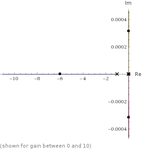tisheebird
Member level 5
I have designed a system which gives a nice response in the simulation. When I checked the poles and zeros plot, it has 1 dominant pole on the real axis and other poles (2nd and 3rd) are exactly with the zero on the real axis. So i have few doubts :
1. Can we call such system 1 pole system.?
2. Such a system is always stable.?
Please guide me give your suggestions.
1. Can we call such system 1 pole system.?
2. Such a system is always stable.?
Please guide me give your suggestions.
